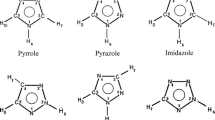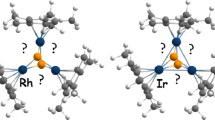Summary
A semiempirical effective Hamiltonian treatment is proposed for transition metal complexes, taking into accountd-electron correlations, weak covalency of the metal-ligand bonds and the electronic structure of the ligand sphere. The technique uses the variation wave function which differs from the usual Hartree-Fock antisymmetrized product of molecular orbitals extended over the whole complex. The scheme is implemented and parameters describing the metal-ligand interactions are adjusted to reproduced-d-excitation spectra of a number of octahedral MF 4−6 (M=Mn, Fe, Co, Ni) anions, Mn(FH) 2+6 cation, CoCl 4−6 anion, and a tetrahedral CoCl 2−4 anion. The values of the parameters are reasonable, thus confirming the validity of the proposed scheme.
Similar content being viewed by others
References
Bethe HA (1972) Ann d Phys 3:133
Jorgensen CK (1971) Modern aspects of ligand field theory. North-Holland, Amsterdam
Sviridov DT, Smirnov YuF (1977) Theory of the optical spectra of transition metal ions. Nauka, Moscow (in Russian)
Ballhausen CJ (1962) Introduction to ligand field theory. McGraw-Hill, NY
Abragam A, Bleaney B (1970) Electron paramagnetic resonance of transition ions. Clarendon Press, Oxford
Lever ABP (1986) Inorganic electronic spectroscopy. Elsevier, Amsterdam
Roothaan CCJ (1951) Rev Mod Phys 23:69
Bobrowicz FW, Goddard WA III (1977) in: Schaefer HF III (ed) Methods of electronic structure theory. Plenum Press, NY, p 79
Schilling JB, Goddard WA III, Beauchamp JL (1986) J Am Chem Soc 108:582
Schilling JB, Goddard WA III, Beauchamp JL (1987) J Phys Chem 91:5616
Schilling JB, Goddard WA III, Beauchamp JL (1987) J Am Chem Soc 109:5565
Newton JE, Hall MB (1984) Inorg Chem 23:4627
Newton JE, Hall MB (1985) Inorg Chem 24:2573
Pierloot K, Vanquickenborne LG (1990) J Chem Phys 93:4154
Rosi M, Bauschlicher CW Jr, Langhoff SR, Partridge H (1990) J Phys Chem 94:8656
Morokuma K (1990) Inorg Chem 29:3110
Filatov MJ, Gritsenko OV, Zhidomirov GM (1987) Theor Chim Acta 72:211
Blyholder G, Head J, Ruette F (1982) Theor Chim Acta 60:429
Zerner MC, Loew GH, Kirchner RF, Mueller-Westerhoff UT (1980) J Am Chem Soc 102:589
Edwards WD, Weiner B, Zerner MC (1988) J Phys Chem 92:6188
Edwards WD, Weiner B, Zerner MC (1986) J Am Chem Soc 108:2196
Kotzian M, Rösch N, Schröder H, Zerner MC (1989) J Am Chem Soc 111:7687
Böhm MC, Gleiter R (1980) Theor Chim Acta 57:315
Böhm MC (1981) Theor Chim Acta 60:233
Beletskii IP, Yatsimirskii KB (1985) Teor i Eksp Khimia 21:1 (in Russian)
Kon'kov KA, Zhidomirov GM, Khelskov VI, Kopranenkov VN, Ivanov YuV (1989) ibidi 25:471 (in Russian)
Bacon AD, Zerner MC (1979) Theor Chim Acta 53:21
Zülike L (1973) Quantenchemie. Verlag der Wissenschaften, Berlin
Clack DW, Hush NS, Yandle SR (1972) J Chem Phys 57:3503
Harrison WA (1990) Electronic structure and the properties of solids. Freeman, San Francisco
Tchougreeff AL, Misurkin IA (1989) Chem Phys 133:77
Löwdin PO (1966) in: Wilcox CH (ed) Perturbation theory and its application in quantum mechanics. Wiley, NY, p 255
McWeeny R, Sutcliffe BT (1969) Methods of molecular quantum mechanics. Academic Press, London
Hubbard J, Rimmer DE, Hopgood FRA (1966) Proc Phys Soc 88:13
Bogolyubov NN (1970) Selected papers, vol 2, Naukova Dumka, Kiev (in Russian)
Parr RG, Ellison FO, Lykos PG (1956) J Chem Phys 24:1106
Pople JA, Beveridge DL (1970) Approximate molecular orbital theory. McGraw-Hill, NY
Slater JC (1960) Quantum theory of atomic structure, Vol 1. McGraw-Hill, NY
Di Sipio L, Tondello E, De Michelis G, Oleari L (1971) Chem Phys Lett 11:287
Soudackov AV (1991) PhD Thesis, Karpov Phys Chem Institute, Moscow, USSR (in Russian)
Böhm M, Gleiter R (1981) Theor Chim Acta 59:127
Serafini A, Savariault JM, Cassoux P, Labarre JF (1975) Theor Chim Acta 36:241
Serafini A, Pelissier M, Savariault JM, Cassoux P, Labarre JF (1975) Theor Chim Acta 39:229
Hilal R (1985) Int J Quantum Chem 28:877
Moore CE (1952) Atomic energy levels. Circular of the National Bureau of Standards 467, Vol 2
Bingham RC, Dewar MJS, Low DH (1975) J Am Chem Soc 97:1285
Barraclough CG, Cockman RW, O'Donnell TA, Snare MJ (1988) Inorg Chem 27:4504
Ferguson J, Wood DL, Knox K (1963) J Chem Phys 39:881
Cotton FA, Goodgame DML, Goodgame M (1961) J Am Chem Soc 83:4690
Moscowitz JW, Hollister C, Hornback CJ (1970) J Chem Phys 53:2570
Hillier IH, Kendrick J, Mabbs FE, Garner CD (1976) J Am Chem Soc 98:395
Allen GC, Clack DW (1970) J Chem Soc A:2668
Sutton LE (ed) (1958) Tables of interatomic distances and configurations in molecules and ions. Chemical Society, London
Johansen H, Andersen NK (1986) Mol Phys 58:965
Shashkin SY, Goddard WA III (1986) Phys Rev B 33:1353
Ng B, Newman DJ (1985) J Chem Phys 83:1758
Ng B, Newman DJ (1987) J Chem Phys 87:7096
Ng B, Newman DJ (1986) Chem Phys Lett 130:410
Janssen GJM, Nieuwpoort WC (1988) Int J Quantum Chem Symp 22:679
Ohanessian G, Goddard WA III (1990) Acc Chem Res 23:386
Schäffer CE, Jorgensen CK (1965) Mol Phys 9:401
Schäffer CE (1968) Struct and Bond 5:68
Schäffer CE (1970) Pure and Appl Chem 24:361
Woolley RG (1981) Mol Phys 42:703
Gerloch M, Woolley RG (1984) Progr Inorg Chem 31:371
Author information
Authors and Affiliations
Rights and permissions
About this article
Cite this article
Soudackov, A.V., Tchougreeff, A.L. & Misurkin, I.A. Electronic structure and optical spectra of transition metal complexes by the effective Hamiltonian method. Theoret. Chim. Acta 83, 389–416 (1992). https://doi.org/10.1007/BF01113064
Received:
Accepted:
Issue Date:
DOI: https://doi.org/10.1007/BF01113064




